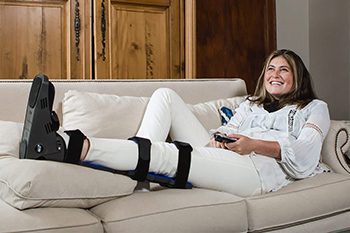
Equinus is a condition in which the upward motion of the ankle joint is limited, making it difficult to bring the foot toward the shin. This restriction can be caused by tight calf muscles, shortened Achilles tendons, or structural issues within the joint. Over time, equinus can lead to a variety of complications, including flat feet, bunions, plantar fasciitis, and even pain in the knees, hips, and lower back. Because equinus affects the way the body moves, it often causes discomfort with walking and running, impacting daily activities and overall quality of life.
One of the most effective non-surgical options for treating equinus is the use of an equinus brace. This device is specifically designed to gently stretch the calf muscles and Achilles tendon, helping to restore flexibility and improve ankle movement. Unlike rigid casts or bulky orthopedic boots, equinus braces are typically lightweight and adjustable, allowing patients to incorporate them into their daily routines with minimal disruption.
The equinus brace works by maintaining the foot in a position that encourages a gradual stretch. This stretching process reduces tightness and helps retrain the muscles and tendons to allow for improved range of motion. Patients may be advised to wear the brace at specific times, such as during sleep or periods of rest, when the body can comfortably adapt to the stretching effect without strain. In many cases, the brace is used alongside physical therapy exercises and supportive orthotics to maximize results.
Benefits of an equinus brace extend beyond improved ankle flexibility. By addressing the root cause of equinus, the brace can relieve pain caused by secondary conditions such as heel pain, arch discomfort, or forefoot pressure. Patients often notice better posture, reduced fatigue while walking, and enhanced athletic performance as mobility improves. For children and adults alike, consistent brace use may also prevent long-term complications that could otherwise require invasive treatment.
Every patient’s case is unique, and treatment with an equinus brace should always be guided by a podiatrist. A professional evaluation will determine the severity of the condition, identify underlying causes, and create a customized treatment plan. In some instances, additional therapies, such as custom orthotics, stretching regimens, or night splints, may be recommended in combination with the brace for optimal results.
Living with equinus does not have to mean living with daily pain or mobility challenges. The equinus brace offers an effective, non-invasive solution that promotes long-term relief and improved function. Early intervention is especially important, as untreated equinus can progress and place added strain on other parts of the body.
If you are experiencing tightness in your calves, difficulty walking, or chronic foot and ankle pain, it may be time to explore whether an equinus brace is right for you. Schedule an appointment with our office today to receive a complete evaluation and learn how this innovative treatment can help restore your mobility and improve your quality of life.
